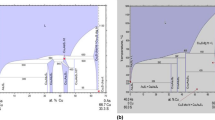Abstract
The phase relations in the Cu-W-S-system were investigated at various temperatures ranging from almost room temperature up to ∼900 °C. The experiments were performed in evacuated silica glass tubes with a minimum vapor space. At low temperatures alteration experiments were carried out in water solutions containing copper(II)-sulfate or iron(III)-sulfate. No ternary phase exists in the system. At 900 °C Cu2S and W are coexisting phases. Tie lines connect WS2 with the digenite-chalcocite solid solution and with a sulfuric liquid containing ∼0.5 wt.-% WS2. Below 813 °C the sulfuric liquid disappears in the Cu-S system (monotectic). On continuous cooling CuS will appear at 507 °C in the Cu-S system and shortly below this temperature covellite coexists with tungstenite. At temperatures below 70 °C tungstenite can coexist with covellite, blaubleibender covellite, anilite, djurleite, and with chalcocite in the pure system. If traces of iron are present anilite will not be formed and digenite remains stable with tungstenite. A new occurrence of tungstenite was observed from the Kipushi mine (Katanga), displaying excellent intergrowth with chalcocite (fig. 4 and 5).
Zusammenfassung
Die Phasenbeziehungen im Cu-W-S-System wurden zwischen 900 °C und Zimmertemperatur durch DTA- und Abschreckungsexperimente in Quarzglas-und in unter Druck kollabierenden Goldampullen, sowie durch eine Reihe von Verwitterungsversuchen und Umsetzungen in wässrigen Lösungen untersucht. Die im System auftretenden Verbindungen sind Cu2S (Kupferglanz), Cu1.97S (Djurleit), Cu1.75S (Anilit), Cu1+xS (blaubleibender Covellin), CuS (Covellin) und oberhalb ∼70°C Cu1.8S (Digenit), sowie WS2 (Tungstenit). Es gibt keine ternären Verbindungen. Von allen genannten Phasen ist nur der Tungstenit über den gesamten untersuchten Temperaturbereich stabil. Das System zeigt bei 900 °C neben Schwefelschmelze (L1) eine Sulfidschmelze (L2). Es handelt sich um das oberhalb 813 °C auftretende Monotektikum im Randsystem Cu-S, welches im ternären System ∼0.5 Gew.-% WS2löst. Die Phase WS2 koexistiert bei 900 °C mit L1, L2 und mit der bei dieser Temperatur lückenlosen Kupferglanz-Digenit-Mischkristallreihe sowie mit W. Außerdem besteht eine Konode zwischen W und Cu2S. Das gegenseitige Lösungsvermögen der Verbindungen ist selbst bei 900 °C gering. Während Digenit ≲0.5 Gew.-% WS2 in fester Lösung aufzunehmen vermag, beträgt umgekehrt die Löslichkeit von Kupfersulfid in WS2≪0.2%. Die Phasenbeziehungen unter 900 °C sind charakterisiert durch das Stabilwerden des Covellins bei 507 °C. Kurz unterhalb dieser Temperatur werden WS2 und CuS nebeneinander stabil. Die Mischungsreihe zwischen Digenit und Kupferglanz ist unterhalb 430 °C nicht mehr lückenlos. Das System Cu-W-S zeigt daher bei 400 °C Konoden von WS2 zu Covellin, Digenit und Kupferglanz. Unterhalb ∼70 °C zerfällt der mit Tungstenit koexistierende Digenit zu Anilit und Djurleit. Bei künstlicher Verwitterung von Kupferglanz oder Digenit mit WS2-Einschlüssen konnten durch teilweise Oxidation mit verdünnter Fe‴-Sulfat- oder Cu″-Sulfatlösung die Kupfersulfide in blaubleibenden Covellin überführt werden, während Tungstenit unter gleichen Bedingungen den Agenzien widerstand, wodurch sich die Koexistenz zwischen Cu1+xS und WS2 nachweisen ließ. Die bei niedrigen Temperaturen mit Tungstenit im Cu-W-S-System koexistierenden Phasen sind: Kupferglanz, Djurleit, Anilit, blaubleibender und normaler Covellin; bei Spuren von im Digenitgitter gelösten Fe tritt Anilit nicht auf, statt dessen ist Digenit mit Tungstenit stabil. Ein neues natürliches Tungstenitvorkommen (Kipushi/Katanga) wird beschrieben, das Mineral ist orientiert in massivem Kupferglanz eingewachsen (Abb. 4 und 5).
Similar content being viewed by others
Literatur
Chace, F. M.: Abbreviations in field and mine geological mapping. Econ. Geol. 51, 712–723 (1956).
Elliott, R. P.: Constitution of binary alloys. 1 st suppl. 877 p. New York: McGraw-Hill 1965.
Graeser, S.: Über Funde der neuen rhomboedrischen MoS2-Modifikation (Molybdänit-3R) und von Tungstenit in den Alpen. Schweiz. Min. Petr. Mitt. 44, Heft 1, 121–128 (1964).
Grover, B., Moh, G. H.: Phasengleichgewichtsbeziehungen im System Cu-Mo-S in Relation zu natürlichen Mineralien. Neues Jahrb. Mineral., Monatsh. (1969).
Grover, B., Kullerud, G., Moh, G. H.: Phasengleichgewichtsbeziehungen im ternären System Fe-Mo-S in Relation zu natürlichen Mineralien und Erzlagerstätten. Neues Jahrb. Mineral., Abhandl. 1973 (im Druck).
Hansen, M., Anderko, K.: Constitution of binary alloys. 2nd ed. 1305 p. New York: McGraw-Hill 1958.
Höll, R., Weber-Diefenbach, K.: Tungstenit-Molybdänit-Mischphasen in der Scheelitlagerstätte Felbertal (Hohe Tauern, Österreich). Neues Jahrb. Mineral., Monatsh. 1, 27–34 (1973).
Kullerud, G.: Review and evaluation of recent research on geologically significant sulfidetype systems. Fortschr. Mineral. 41, 221–70 (1964).
— Covellite stability relations in the Cu-S system. Freiberger Forschungsh. C 186, 145–160 (1965).
— Experimental techniques in dry sulfide research, p. 289–315. In: Research techniques for high pressure and high temperature (ed. by G. C. Ulmer), 367 p. Berlin-Heidelberg-New York: Springer 1971.
— Yund, R. A.: Cu-S system (abstr.). Geol. Soc. Am. Bull. 71, 1911–12. (1960).
—: The Ni-S system and related minerals. J. Petrol. 3, 126–175 (1962).
Moh, G. H.: Blue remaining covellite and its relations to phases in the sulfur rich portion of the copper-sulfur system at low temperatures. Mineral. Soc. Japan, Spec. Pap. 1 (Proc. IMA-IAGOD Meetings '70, IMA-Vol.), 226–232 (1971).
— Vergleichende experimentelle Untersuchungen an molybdän-und wolframhaltigen Sulfidsystemen. Fortschr. Mineral. 50, Beiheft 1 (Referate), 65–67 (1972).
— Taylor, L. A.: Laboratory techniques in experimental sulfide petrology. Neues Jahrb. Mineral., Monatsh. 10, 450–59 (1971).
Morimoto, N., Kullerud, G.: Polymorphism in digenite. Am. Mineralogist 48, 110–123 (1963).
— Koto, K.: Phase relations of the Cu-S system at low temperatures: stability of anilite. Am. Mineralogist 55 106–117 (1970).
Oosterbosch, R.: Gécamines, Likasi/Zaïre, personal communication April 1973 (1973).
Ramdohr, P.: The ore minerals and their intergrowths, 1174 p.; English translation, 3rd edit. Oxford: Pergamon Press 1969.
Roseboom, E. H.: An investigation of the system Cu-S and some natural copper sulfides between 25° and 700°C. Econ. Geol. 61, 641–672 (1966).
Shunk, F. A.: Constitution of binary alloys. 2nd suppl., 720 p. New York: McGraw-Hill 1969.
Štemprok, M.: The iron-tungsten-sulphur system and its geological application. Mineral. Deposita (Berl.), 6, 302–312 (1971).
Udubasa, G., Moh, G. H.: The Mo-W-S system; unpublished research, Heidelberg (1972).
Author information
Authors and Affiliations
Rights and permissions
About this article
Cite this article
Moh, G.H. Das Cu-W-S-System und seine Mineralien sowie ein neues Tungstenitvorkommen in Kipushi/Katanga. Mineral. Deposita 8, 291–300 (1973). https://doi.org/10.1007/BF00203210
Received:
Issue Date:
DOI: https://doi.org/10.1007/BF00203210




